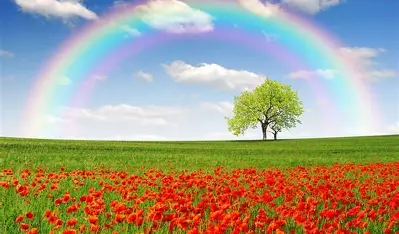What is a rainbow and how is it made?

The Formation Process
- Sunlight and Water Droplets: Rainbows primarily occur when sunlight interacts with water droplets in the air, such as those from rain, fog, or sprays. The sunlight is composed of white light, which contains all the colors of the visible spectrum 2.
- Refraction of Light: When sunlight enters a raindrop, it slows down and bends due to the change in medium from air to water, known as refraction. This bending occurs because different colors of light travel at different speeds in water, causing them to separate 2.
- Reflection Inside the Droplet: After refraction, the light reflects off the inner surface of the raindrop. This internal reflection redirects the light back toward the front of the droplet 2.
- Second Refraction: As the light exits the raindrop, it is refracted again. This second bending causes the light to spread out further, creating the band of colors that we observe as a rainbow 2.
6 Πηγές
The Spectrum of Colors
- The colors of a rainbow appear in a specific order due to the varying angles at which the different wavelengths of light are refracted. The sequence of colors, often remembered by the mnemonic “ROYGBIV,” includes: Red, Orange, Yellow, Green, Blue, Indigo, and Violet2 .
- Red light exits the raindrop at a larger angle (approximately 42 degrees) compared to violet light (about 40 degrees), which results in red appearing on the outer edge of the rainbow and violet on the inner edge 3.
5 Πηγές
Conditions for Visibility
- To see a rainbow, the observer must be positioned with the sun behind them and the rain in front. This is usually optimal when sunlight is low in the sky, such as during early mornings or late afternoons 2.
- Rainbows can often be seen following rain showers when the sky is sunny and clear 2.
4 Πηγές
Additional Information
- Double Rainbows: Sometimes, a second rainbow, known as a double rainbow, forms outside the primary arc due to light reflecting twice inside the water droplets, causing the color order to be reversed 2.
- Optical Illusion: Although rainbows appear as colorful arcs in the sky, they are actually optical illusions formed by a specific arrangement and alignment of raindrops and sunlight. Each observer sees their unique version of a rainbow based on their perspective 2.
4 Πηγές
In summary, rainbows are beautiful meteorological phenomena resulting from the interaction of sunlight and water droplets, demonstrating the wonders of light and color in nature.
Leave a Reply